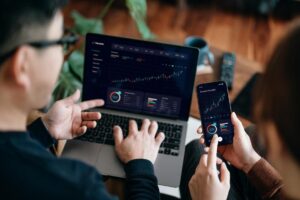Mykola Lukashuk, CEO at Marketing Link, is a B2B SEO, analytics, and ads consultant.
AI has changed search engine optimization (SEO)—maybe not completely, but in a big way. On the one hand, AI can save you money—you can get content and even a full strategy for free. On the other hand, you now need more content and more quality content to stand out from the sea of content being generated by competitors using AI.
To better understand what drives SEO traffic growth in 2025, you first need to consider the fundamentals. Traffic growth depends on three things at once: technical optimization, on-page optimization and off-page optimization. I’d also add that you need a bit of luck, but since that’s hard to control, let’s focus on the measurable factors. Here’s my advice for how to optimize in each area:
Technical Optimization: Speed, Structured Data, Security
Five years ago, technical optimization was pretty basic. It may have involved fixing redirects, adjusting the robots.txt file and cleaning up your sitemap. But today, the expectations are much higher. Google and Microsoft now prioritize site loading speed. And if you’re thinking desktop—think again. Mobile networks come first, especially slower connections.
Google uses two types of data to measure page speed: field data (think what you get from PageSpeed Insights) and real-world data (collected over 28 days and shown in Core Web Vitals). Because of this, optimization is no longer a simple “fix it and see the results” process. Now, it looks more like this:
• Identify a problem.
• Apply fixes.
• Test with multiple tools (PageSpeed, Lighthouse, etc.).
• Wait for the data to update in Google Search Console and Microsoft Bing Webmaster Tools (which takes about a month).
• Review the impact.
• Adjust again if needed.
This leads to what many SEO specialists describe as an endless loop of testing and tweaking: You fix one thing, another issue shows up. You test across tools and you get different results each time.
Besides speed, structured data also plays a key role. It helps search engines better understand your pages. Even if your content management system (CMS) automatically generates your sitemap and robots.txt, you shouldn’t assume they’re perfect. Make sure they’re clean, current and doing what they’re supposed to. Don’t forget about server-side settings and caching, either. Proper setup can significantly speed up how fast your content loads.
Technically, Google can index a website without an XML sitemap—but it expects you to handle that. It’s a way to show you know what you’re doing. That’s why clean technical structure and optimization are still essential SEO foundations.
Bing Webmaster Guidelines also include Bing user experience (UX) optimization tips, similar to Google’s Core Web Vitals. They rely on Lighthouse and prioritize user-friendly websites. Page speed doesn’t directly impact the ranking of a specific page as much as it affects bounce rates and overall crawl efficiency, so new content may take longer to get indexed. The website can also be penalized due to security issues.
On-Page Optimization: Meta Tags And Content
Earlier this year, Google made it clear that low-value AI-generated content won’t perform well in search results. You’ve probably seen this yourself. Chances are your competitors tried using AI for content creation. Some may have even gotten short-term traffic from it—only for those pages to gradually disappear from the rankings. Bing doesn’t explicitly devalue AI-generated content, but its Webmaster Guidelines recommend avoiding auto-generated content that lacks user value.
If you’ve also been relying on mass-produced content, now is a good time to rethink your strategy. Start by reviewing which parts of your content were AI-generated. Then, start rewriting and manually adapting those pieces.
Besides the content itself, meta tags are just as important. Consider your:
• Title: This is a key SEO factor. It needs to be clear and include your primary keyword.
• Description: It doesn’t directly impact rankings but affects your click-through rate. A strong, engaging description can attract more clicks.
• H1-H3 Headings: Headings help both search engines and readers understand the structure and topic of the page.
Off-Page Optimization: PR Articles And Media Mentions
The third component of SEO is off-page optimization (i.e., backlinks), which includes PR articles and media mentions. PR articles often include backlinks by default, but that doesn’t mean all links are equally valuable.
For example, you can:
• Post on social media.
• Publish for free on platforms like WordPress or Medium.
• Leave a comment in a forum discussion.
• Get a backlink from a local Chamber of Commerce.
• Give an expert interview or participate as a partner at an industry event.
All of these are considered backlinks, but the quality and SEO impact vary drastically. That’s why it helps to break down off-page SEO into different types:
• High-quality, evergreen PR articles (press releases, guest posts)
• Link insertions, user-generated backlinks (comments, forums, Q&A sites)
• Brand mentions without hyperlinks (still valuable for brand recognition)
• Niche directory backlinks (for example, marketers often use Clutch or Design Rush)
A smart balance across these formats can help you build a strong backlink profile and improve your SEO rankings.
Key SEO Priorities For 2025
As we look to the second half of the year, here are the key priorities for SEO that I recommend focusing on:
Avoid AI-generated content.
If traffic is declining, rewrite and manually improve your most important pages first.
Improve site speed.
Don’t just check the homepage—optimize service or category pages, blog posts and news articles, as well.
Monitor website security.
Update all plug-ins, install a web application firewall, secure admin access and enable activity logging.
Focus on high-quality PR articles.
Don’t waste time on generated comments or directories that disappear in a week. A well-written expert article on a reputable site will likely not only bring backlinks, but also real traffic and qualified leads.
Sustainable SEO in 2025 means playing the long game. Stay focused on foundational tactics that continue to deliver measurable results.
Forbes Business Council is the foremost growth and networking organization for business owners and leaders. Do I qualify?
Read the full article here











